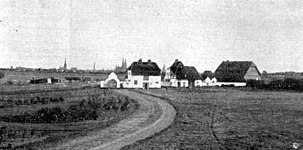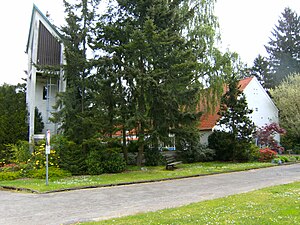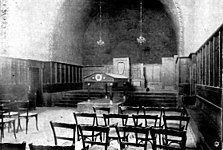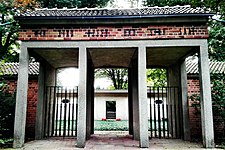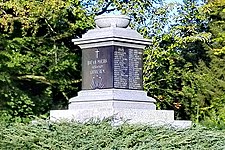Vorwerker cemetery
The Vorwerker Friedhof in the north of the city is the largest of the six municipal cemeteries in Lübeck with an area of 53 hectares. On it are, among other things, the war cemeteries of various nations from the First World War and Second World War .
location
The cemetery extends in an oval. It is bounded on its long sides by Friedhofsallee and the Fackenburger Landgraben . It borders on Stockelsdorf . From Friedhofsallee there are entrances 1 to the administration and crematorium, entrance 2 to chapel 1, entrance 3 to chapel 2 and entrance 4 for pedestrians to the Jewish cemetery. Line 7 of local transport in Lübeck goes to the Vorwerker Friedhof.
investment
The history of the cemetery goes back to 1902. On April 30 of that year, the citizens' committee refused to set up another cemetery for the suburb of St. Lorenz on Schönböckener Strasse. The Senate turned then to determine a size of 21 ha 01 a 39 sqm for the construction of a cemetery on November 22, the request, the earlier contemplated, belonging to the state land on Vorwerker way between clutter village and Vorwerk. The finance department had set the cost of the takeover at around 94560 Mk. (49 Pfg. Per square meter), while the preliminary costs were supposed to be 243450 Mk. In order to widen the old dirt road to 15 meters and to create several buildings, several strips of land had to be acquired. The construction of the chapel was initially not approved by the city council on July 18, 1904. The morgue, which looked like an old Vicelin church, was more spacious than the one on Israelsdorfer Allee . As in the chapel of the Allgemeine Gottesackers , where a stork usually nested at that time in summer, the new morgue was not missing the symbol of death in addition to the symbol of life. While the cemeteries were previously administered by a state authority, the churchyard and burial deputation, the Vorwerker cemetery became the property of the municipality of Lübeck on September 17, 1906 by a resolution of the citizens .
- Vorwerker Friedhof 1906
The cemetery was designed by Erwin Barth as a garden cemetery and its facility was entrusted to August Langenbuch , cemetery supervisor of the cemetery deputation. With the first burial on May 13, 1907, the largest cemetery in the city was opened. The members of the cemetery authorities and the board members of the St. Lorenz and St. Matthäi congregations were invited to the funeral of the elderly fellow citizen from St. Lorenz .
Cemetery chapel 1 was built from 1908 to 1909 according to plans by Carl Mühlenpfordt in the style of homeland security architecture .
With the timetable change in 1908, the cemetery was connected to local public transport by tram via a branch line from Fackenburger Allee .
Cremation has also been possible in the cemetery since 1910.
In 1926, the cemetery was expanded according to plans by the city's garden architect Harry Maasz . Cemetery chapel 2 was inaugurated on December 6, 1958. In the same year the interior of Chapel 1 was modernized and decorated with the resurrection frieze by Curt Stoermer .
The cemetery is crossed by two long streets between chapels 1 and 2. A kind of circular path in the cemetery connects the entrances to Friedhofsallee and then runs parallel to the Fackenburger Landgraben .
The citizens of the Hanseatic City of Lübeck decided on February 26, 2015, to open a segment of the cemetery between Entrance 3 and Fackenburger Landgraben in the medium term, i.e. H. until 2030 or 2050.
- investment
Crematorium and urn graves
- crematorium
At the far end of the cemetery, close to the land moat that marks the border between Lübeck and Oldenburg, the new state crematorium was originally built as a cremation church with a vestibule. It was the first of its kind in present-day Schleswig-Holstein . In the Prussian province of Schleswig-Holstein , it was only decided in 1912, built in Kiel and put into operation in 1916.
The simple vestibule can be reached from the outside through the portal to which a wide flight of stairs bordered with mighty square stringers led. From here a staircase led up to the choir and then a second double door led into the main hall or burial hall, which was equipped with large, slender windows. That room has large, slim windows. At the back of the main hall, on a small elevation, to which steps led up, stood the blessing pulpit. A round arch spanned over them . Right in front of her, between the pillars supporting a canopy, was the recess. To the north of the funeral hall was the sacristy and to the south a narrow room for the relatives. Under it, the combustion chamber with the in was firebricks executed incinerator. The ashes were collected in the furnace below and placed in a capsule . This could be buried in the urn cemetery part of the Vorwerk cemetery, which was then surrounded by the cremation church on three sides . With its high and massive granite plinth , its steep roof and its pleasing lines, it blended into the landscape and the building artist, building inspector Carl Mühlenpfordt , created a monument with it. The interior design of the cremation church, however, did not succeed as well as the exterior.
On March 22, 1910, a test cremation that was satisfactory to all sides took place in the new state crematorium . Langenbuch, with whose assistance all the buildings in the cemetery were once designed and built , explained the individual facilities and processes in detail to the citizens who visited the crematorium on May 12th. The shell of Countess Louise von Baudissin, mother of the writer Count Wolf von Baudissin (Baron von Schlicht) was the first body to be cremated on May 17th and the crematorium was inaugurated.
The city sold the loss-making crematorium to a private operator. In the course of structural changes in the 1980s, the outside staircase, like the entire building, was gutted and converted to an extension of the interior. Today only cremations take place in the crematorium and the urn cemetery part was already closed as such. Today you can walk there via the “Garden of Reflection” to the no longer existing path in front of the above-mentioned “Memorial for the Victims of Tyranny”. Today urn burials take place anonymously in the cemetery, in communal graves for urns, urn lawn row graves, urn lawn election graves or urn stele graves.
Graves
Graves of famous people
- Kurt Diedrich (1905–1982), German teacher and non-fiction author
- Heinrich Albrecht Gütschow (1767–1839), merchant and councilor of the Hanseatic city of Lübeck
- Johannes Hefti (1881–1936), businessman and spokesman for the Lübeck citizenship
- August Heinrich Niebour (1889–1929), senator and judge
- Hans Pieper (1882–1946), architect, preservationist and construction officer
Sisterhood of the German Red Cross
At the end of 1939 the Sisterhood of Lübeck received a tomb of a special character . This was not dedicated to an individual, but to the community of women who dedicate their lives to a common task and then find a common resting place. The Sisterhood of the German Red Cross had at that time in Luebeck their biggest Mother House , where were sent from their members to community service, but also a burial ground, where they held retreats to rest.
Between a birch path and a high beech hedge , the graves with their various tablets were lined up with no particular reference to the resting.
Ottilie Schäfer (1889–1971), superior of the sisterhood and sculptor, crowned this tomb with the planning and execution of a joint memorial. She arranged for the purchase of the bronze sculpture "Hands" by the sculptor Georg Kolbe from Berlin made by the art foundry Hermann Noack in Friedenau and, together with the master, created a stone substructure as a soul that supports the sculpture.
These hands should be an expression of the life's work of the sisters , who provide comfort and relief without words .
The former burial ground is no longer used today. In 1977, and then since the turn of the millennium, part of Block 28 is used. The memorial there also has “hands” based on the Kolbe sculpture.
Community graves
The lawn grave for the medical science helpers is marked in block 51 by a boulder.
War cemeteries
The war management of the IX. Army Corps of Altona was built at the beginning of the First World War one as Barack hospital designated military hospital , which was Germany's largest hospital in the war, on the castle field . For those who died there, the cemetery authorities had provisionally made the most beautiful place available behind the main chapel of the Vorwerk cemetery , as the construction of a grove was planned. The first burials took place in unadorned circumstances. There were already eight Germans in the trenches on one side and six, three Russian and three French, dead there when this changed on November 23, 1914 with great sympathy among the people of Lübeck. Christian Reimpell , chief pastor of the Lübeck Garrison Church , carried out the funerals.
From the end of April, the corpses of the concentration camp prisoners who died before the bombing of the Cap Arcona (ship, 1927) were only buried in mass graves and without coffins. Almost 3,000 dead from concentration camps, Germans, Dutch, Poles, Estonians, Latvians, Ukrainians and Russians, rest in the cemetery. The deceased American, British, French, Belgian and Norwegian military personnel were transferred to their hometowns in 1947–1949. Graves / memorials are created for the following groups of victims:
- In the memorial, victims of war and tyranny rest in a walled courtyard in Block 20. The side walls of the memorial are reminiscent of the stages of suffering with a surrounding sgraffito by Walther Jahn.
- The only remaining direct route to the memorial leads down a flight of stairs to the back entrance of the memorial. In the courtyard in front of the entrance is the grave of the unknown victim. On its stone it says:
The nameless victim
those
who rest in German and foreign lands far from home
those
those who consumed the embers of the fire and who had to die from poisonous gases
those
who devoured the greed of water and found death in the waves
those
the air defeated and their fate - equal to the Ikaros - fell.
- Through the main portal, above which the words "WE ARE VICTIMS AND ARE SAAT", one arrives at the burial ground of the former urn cemetery, which is now a garden of reflection. This is cut in the valley by a path that leads to the monument to the Lithuanians in the most remote part of the cemetery. On the other side is the crematorium.
- In front of the side walls in the inner courtyard there are gravestones of victims such as Erich Klann or Karl Ross .
- Russian war cemetery : Russian soldiers First World War in Block 21 and Russian war dead Second World War in Block 32.
- Dutch forced laborers from the Second World War from Berlin and Schleswig-Holstein are buried on the Dutch war cemetery (Dutch: Erebegraafplaats Lübeck) in Block 37, which is located within the Vorwerker Friedhof.
- Poles and deaths from concentration camps in Block 39
- Ukrainian cemetery for refugees, which is located within the Vorwerker Friedhof, Friedhofsallee in Block 36
- Estonian war cemetery in Block 26 for the Estonians buried in Schleswig-Holstein.
- Lithuanian memorial for the refugees who died in exile in Lübeck during the Second World War.
- German war cemetery Vorwerker Friedhof : German soldiers from the First World War in Block 3 and 15 and from the Second World War in Block 12. War cemetery for bomb victims and displaced persons in Block 13
- Latvian war cemetery in Block 23
- Isolated war graves from several nations from reburial : In 2014, 24 individual war graves, which were previously scattered around the Vorwerk cemetery, were brought together in field 23/3.
- War cemeteries
Web links
- Vorwerker Friedhof - Park and cemetery in one
- Cemetery plan of the Vorwerk cemetery
- The technical side of death
Individual evidence
- ↑ The Vorwerker Friedhof
- ^ Cemetery plan of the Vorwerker cemetery
- ↑ At the "Vorwerker Friedhof". In: Vaterstädtische Blätter , year 1906, No. 40, edition of September 30, 1906, pp. 161–163.
- ^ Vorwerker Friedhof. In: Hanseatic City of Lübeck: The cemetery guide. Mammut-Verlag, Leipzig, 2nd edition March 2013, pp. 30–34.
- ^ Cemetery plan of the Vorwerker cemetery
- ↑ Hanseatic City of Lübeck, The Mayor, Urban Green Area and Traffic: Changes to the municipal cemeteries Vorwerk and Waldhusen. Information sheet of March 31, 2015.
- ↑ The Ostholstein district was not created until April 26, 1970 in the course of the district reform in Schleswig-Holstein from the districts of Oldenburg in Holstein (former part of the Oldenburg Free State ) and Eutin (former Principality of Lübeck ).
- ↑ Kiel crematorium
- ↑ The Lübeck crematorium. In: Vaterstädtische Blätter , year 1910, No. 24, issue of June 12, 1910, pp. 93–95.
- ↑ March 22nd was a special date for symbolic acts in the German Empire, as the heroic emperor was born on March 22nd, 1797 .
- ↑ Weekly Chronicle. In: Vaterstädtische Blätter , year 1910, No. 13, edition of March 27, 1910, p. 52.
- ↑ Weekly Chronicle. In: Vaterstädtische Blätter , year 1910, No. 20, edition of May 15, 1910, p. 80.
- ↑ see death of Countess Louise Countess Baudissin with contemporary newspaper reports.
- ^ Vorwerker Friedhof - Park and cemetery in one
- ↑ Hans Pieper : The memorial of the sisterhood of the German Red Cross. In: Lübeckische Blätter , 82nd year, supplement, number 12, edition of March 14, 1940.
- ↑ In the graveyard of the fallen warriors. In: Lübeck advertisements . 166th vol., No. 595, edition of November 24, 1914.
- ↑ Wilfried Fick: Lübeck cemeteries. Cemetery of honor. Hanseatic City of Lübeck - Department of Planning and Building, Lübeck 2010 ( Lübeck plans and builds 103, ISSN 0933-193X ).
- ↑ Albrecht Schreiber: Vorwerker Friedhof Lübeck: Carl Höppner's last honor for the victims of violence and terror. In: Ohlsdorf - Zeitschrift für Trauerkultur 89, II, 2005 - May 2005
- ↑ Many residents of the Baltic States , who once greeted the Germans as liberators from Russia , stayed in Lübeck after the war. At home, they would have been considered collaborators . They died in Lübeck, became German or emigrated.
- ^ Vorwerker Friedhof. In: Hanseatic City of Lübeck: The cemetery guide. Mammut-Verlag, Leipzig, 2nd edition March 2013, pp. 30–34.
- ^ History of the Vorwerker Friedhof at www.weltkriegsopfer.de ( page no longer available , search in web archives ) Info: The link was automatically marked as defective. Please check the link according to the instructions and then remove this notice.
- ↑ Because of the exposed position of the grave, the suspicion is that its stone, when the main entrance of the monument was directly accessible, was on the opposite side of the courtyard in front of the main portal.
- ↑ Russia thanks you for looking after the war graves. In: HL-live.de, archive from December 17, 2014
- ^ Volksbund deutsche Kriegsgräberfürsorge e. V., Schleswig-Holstein State Association: New war cemetery in Lübeck
Coordinates: 53 ° 53 ′ 41.3 " N , 10 ° 39 ′ 50.8" E
